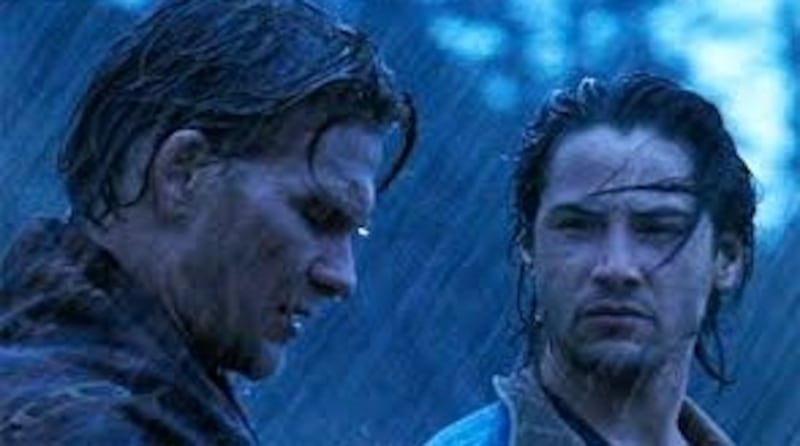There are few more interesting Hollywood careers than that of the late Patrick Swayze, the dirty-blond heart-throb whose chiselled face was more or less inescapable through the 1980s and 1990s. The high practitioners of the acting craft - the Penns and Derns, your Streep, your Day-Lewis - are all very well.
But who can match the full-octane, clench-jawed glory of peak Swayze as he moved from big bro' to the entire Brat Pack in SE Hinton's Outsiders to Johnny Castle, the dance instructor who made an entire generation of cinema goers swoon, delivering one of the immortal power ballads in the process, then provoking with Demi Moore an international spike in the popularity of pottery classes before hauling on the wetsuit and grabbing a surfboard for what is possibly his defining silver screen moment?
Point Break reaches its 30th anniversary this year and has lost none of its brilliance, daftness and general strangeness. It rarely features in the 'great sports films' conversations even though it features one of most technically ambitious and dangerous athletic scenes ever committed to celluloid. It comes at the very end of a film when Swayze's character Bodhi, a soul-searching LA surfer who explores his mystic side when not robbing banks, decides he'd literally rather die in a vast ocean swell than spend another second handcuffed to Keanu Reeves.
"Look at it," he tells Johnny Utah, Reeve's college-football-star-turned-undercover detective who slowly falls under the spell of both the surf culture and Swayze's violent perm. The pair gazes out on vast crashing mountains of ocean water on a soaked and sombre day. To casual observers, they might be in Bundoran of an August. But no: Bodhi has come to Bell's Beach in Australia to surf a swell that materialises once every 50 years. His entire life has been leading to this moment.
Gary Neville has perfected the chipper Manc with Liverpool chip on his shoulder
Spirit of the Leaving Cert class of 2021 an inspiration for the year ahead
Sideline Cut: Mayo will be a county of a hundred thousand vigils come 5pm
Keith Duggan: Time to start paying more than lip-service to Irish women’s sport
The scene was actually filmed in Hawaii and Swayze persuaded Darrick Doerner, a famed big wave surfer, to stand in as his stunt double. "I need you to die for me, man," he told Doerner cheerfully on the phone. Because the beach was crowded with fans desperate for a glimpse of the movie stars, they actually met on the water.
Dirty Dancing
"He'd done Dirty Dancing and movies like that, so I knew who he was," Doerner told Paul Evans in Wavelength magazine last summer. "So I'm out at Chun's and sure enough I see him paddling over all kinda kooky and awkward, he wasn't really a surfer. He paddles up to me and we talked and I like him right away. He was a really beautiful person, a truly awesome human being."
Doerner enlisted the legendary Laird Hamilton to put a stop on the local surfers so he could complete the stunt scene for Bodhi's spectacular and, the viewer assumes, fatal wipe-out in the otherworldly swell. The scene presaged the Oscar winning pyrotechnics and skill which its director, Kathryn Bigelow, would showcase in later films Hurt Locker and Zero Dark Thirty.
And that a film bursting with testosterone was directed by a woman is one of the many unusual aspects of Point Break. It’s impossible to pin down, filled with corny-sincerity, cheeseball humour, a non-stop soundtrack, several powerful moments and stylised surf scenes.

How dead inside must you be if you can't warm to a film that takes time to include a thoroughly ridiculous fight scene between the Red Hot Chili Peppers' Anthony Keidis and the wonderful if old-enough-to-be-his father Gary Busey?
And who can deny that once you hear Keanu Reeves declare in his best stoner tone “Caught my first tube today, sir”, you will continue to hear it for the rest of your life, whether you want to or not. Swayze, as ever, physically hurls every ounce of his being into the role. He and only he possessed the kind of fervent sincerity that allowed him to get away with saying things like “they only live to get radical” without making the audience hate him.
Truly spectacular
The action scenes - the football on the beach, the sky-diving, are truly spectacular. And the robberies, where the gang disguises themselves with rubber face masks of Nixon, Reagan, LBJ and Carter seem like a slyly subversive joke on . . . everyone.
1991 was a year of big statement films but while Silence of the Lambs and Thelma and Louise and Cape Fear remain rooted to a time and place and sensibility, the brashest surf film of them all has shape-shifted and travelled and made it through. The remake has come and disappeared without trace but there’s a good thesis to be written of the effect the original had on the brainwaves of the 10-15-year-olds around the world at the beginning of the last decade of the 20th century.
For more than any other film of that time, Point Break seemed to announce what lay ahead in the grungy, baggy, anything goes 1990s, with greed and anti-capitalist forces clashing, America emitting its last lion’s roar of unfettered optimism and the quest for one’s precious spirit moving from the remnants of the hippy era into a multi-billion health and spirituality industry. And Lord only knows how many surfers it spawned.
“Ain’t it wild?” Bodhi tells Johnny Utah during one of their many chats about value systems.
“You can do what you want and make up your own rules. Why be a servant to the law when you can be its master?
Yup, standing on a stormy beach in 1991, old Bodhi had a pretty clear view of the next three decades.
















